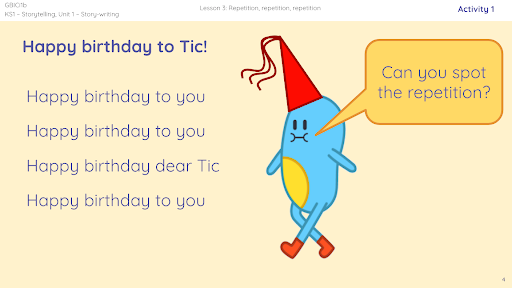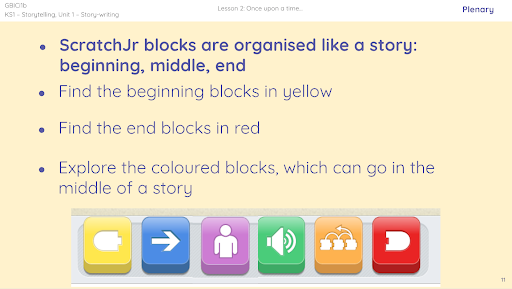Gender Balance in Computing: Trialling a storytelling teaching approach
10 May 2022

Our Gender Balance in Computing programme is the largest national research effort to date to explore ways to encourage more girls and young women to engage with the subject. Since early 2019, we have been working with partners and schools to trial different interventions that aim to positively impact girls’ and young women’s engagement with computing.
Today we have published the first of a series of evaluation reports. The report concerns the feasibility of our pilot study of a teaching approach based on storytelling in key stage 1.
This was a small pilot study, designed to ascertain whether it could be worthwhile to trial this relatively new approach to teaching computing at a larger scale. We are pleased to report that the independent evaluators found that it has evidence of promise.
Storytelling for teaching computing
Across the Gender Balance in Computing programme, we have designed interventions to address areas that have been identified in previous research as barriers to girls’ engagement with computing. Young children are often introduced to computer programming by using code to make simple games. Although this can be engaging for some children, historically, games have often been seen to be more engaging for boys than for girls*. For this intervention, we drew on evidence that storytelling and story-writing can be engaging ways to teach computing, based on research in middle schools**. Given that storytelling is a well-used approach in the teaching of younger children, we decided to explore whether it could be used to effectively teach computing to younger children.
Resources
We designed a unit of work for key stage 1 teachers, with 12 weeks of lessons using storytelling to teach computing concepts. Pupils were taught computing concepts such as sequencing and repetition, linked to familiar story elements such as structure and rhyme. They used the block-based programming language ScratchJr to implement these elements in code, and created their own stories with code using computing concepts.
The lessons reintroduced pupils to elements of stories and let pupils explore how they relate to computing concepts that they could use in animations and other ScratchJr projects.


Pupils discussed the concepts and learnt how they could use ScratchJr blocks to program familiar stories. The lessons guided the class through creating short sections of stories as animations, before setting an extended task for pupils to plan their own story and tell it through code.
What we learnt
From the trial itself:
- The intervention was found to be acceptable for pupils and feasible for teachers.
- The intervention has evidence of promise.
- The independent evaluators recommended proceeding to a full trial.
From teachers’ feedback about the trial:
- Some teachers suggested that the training could be shortened.
- Less experienced teachers highlighted the need to ensure that the training introduces teachers to all of the content covered in the lessons.
- More experienced teachers suggested allowing flexibility to skip some lessons based on the existing skills and knowledge of their classes.
From the implementation of the trial:
- For future trials, the recruitment team will need to review strategies to ensure that as many schools as possible stay engaged with the trial and complete it.
- For future trials, it was recommended that more testing of the surveys be carried out to ensure that pupils are able to complete the surveys on their own and that teachers feel that it is feasible to administer the surveys within existing time constraints.
The independent evaluators found that the intervention has evidence of promise, and recommended that it be scaled up to a larger trial. Such a trial would allow us to see whether the teaching approach has a measurable positive effect on attitudes towards computing, and whether it encourages more girls to engage with computing at scale. This would mean working with a large number of schools, and the evaluators raised the need to make sure that we could recruit and retain a large enough number of schools in light of the disruptions related to the pandemic.
Teachers gave some really useful feedback that we could adjust the training provided on the teaching approach. They said that we could make the training shorter, but would need to make sure that we include all of the lesson content in it for less experienced teachers. More experienced teachers asked for more flexibility in how they deliver the lessons so that they could adjust them for the previous experience of their classes.
This is a pilot study, based on emerging research, so the evaluation report provides further evidence that storytelling is a promising approach for teaching computing.
Future work
This is the first of a number of evaluation reports that will be published as part of the Gender Balance in Computing research programme. Research projects explore different teaching approaches, the importance of relevant content, interventions in non-formal education contexts, approaches to building a sense of belonging, and the impact of school subject choice systems.
You can find the full evaluation report about the Storytelling intervention on the Teaching Approach page.
If you would like to find out more about the research programme and be notified when we publish new findings, you can sign up to our Gender Balance in Computing newsletter.
References
*Kafai, Y. B., & Burke, Q., Beyond Game Design for Broadening Participation: Building New Clubhouses of Computing for Girls. In: Proceedings of Gender and IT Appropriation. Science and Practice in Dialogue — Forum for Interdisciplinary Exchange. European Society for Socially Embedded Technologies. 2014. pp. 21–28.
**Kelleher, C., Pausch, R., & Kiesler, S., Storytelling Alice Motivates Middle School Girls to Learn Computer Programming. In: Proceedings of the SIGCHI Conference on Human Factors in Computing Systems. New York: Association for Computing Machinery. 2007. pp. 1455–1464.